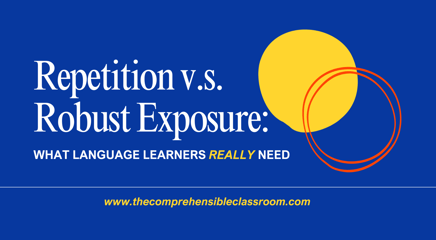As you know, NOVELTY in lesson planning is a big deal. When we aren't switching up the content (silly stories, current events, classic literature, pop culture, history...), we're switching up the delivery. We're switching up the task. We're switching up the groups. We're always doing something new because brains crave novelty (gracias, Krashen via Gaab).
PQA is a staple--quite possibly the staple element in a TCI course. "Personalized Questions and Answers" is really just a catchy way of saying "personalized class discussion". The teacher directs the conversation so that she or he retains the ability to "comprehensify" and correct the content being generated by students. The initial topic is typically determined by the teacher, but the direction and duration of the conversation is entirely dependent on the students.
Well, if you've spent any length of time teaching with comprehensible input, you have probably hit a PQA wall at some point in one or more of your classes. Some teachers and some classes never hit that wall--but I think that most do. Either you are neither naturally skilled or well trained in the art of keeping comprehensible conversation going (I would place myself in this boat), or you have a class that just does.not.like.to.talk. Like my first period class two years ago. They never said anything. I am sure that some teachers, either more gifted or better trained in this area, would have had been able to get them to talk, but I could not...unless, of course, I had a hook or an activity.
I presented some PQA hooks at iFLT last summer, and here is a new one to add to the list: Hide and Speak. I read about it in this post from BusyTeacher.org. So here's what you do:

ORIGINAL ACTIVITY
- Write a bunch of questions on index cards (one question per card). Remember how many cards you have ;-)
- Hide the cards around the room before students arrive--not too hard; they should be found at some point!
- Divide the class into teams--two teams is just fine.
- Send the students on a question card hunt.
- When a student finds a card, s/he brings it to you, the teacher.
- You, the teacher, ask the question to the student.
- If the student answers it correctly, that student receives a point for his her team.
- The team with the most points after all cards have been found is the winner!
TCI MODIFICATION
Remember that we want to milk as much comprehensible input out of each class as we can. In the original activity, there is essentially no comprehensible input happening: it's a fun output activity, but it's not a great fit for a TCI class. A few minor tweaks, though, and we have a brilliant new way to PQA:
- Write a bunch of questions on index cards (one question per card). The questions must be comprehensible to students. You could write them using new target structures for a story that you are about to ask in class if the translations are written on the board! For example, write out ten questions from the 'Personalized questions for class discussion from this Despicable Man story script. Remember how many cards you have ;-)
- Hide the cards around the room before students arrive--not too hard, they should be found at some point!
- Divide the class into teams--two teams is just fine.
- Send the students on a question card hunt.
- When a student finds a card, s/he brings it to you, the teacher.
- You, the teacher, tell everyone in the class to freeze and ask the question to the student. (You might want to use one of these call and response signals to get everyone's attention.)
- If the student answers it
correctly, that student receives three points for his her team since she or he found the question and responded. - Then, put all of your essential TPRS®/CI strategies to work (circling, fishing for details, checking for comprehension), and keep the conversation going!
- Give one point to anyone that contributes something significant to the conversation. Don't be a jerk about it--if a student strings together something that is intelligible and longer than a couple words, give the student a point!
- The team with the most points after all cards have been found and discussed is the winner!
And there you go--it's the same PQA as always, you just injected a little novelty :)




